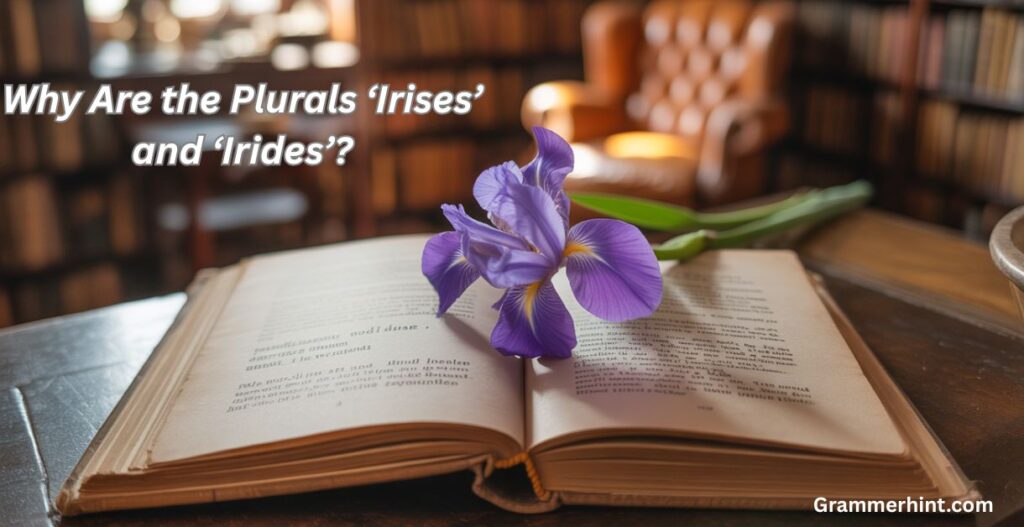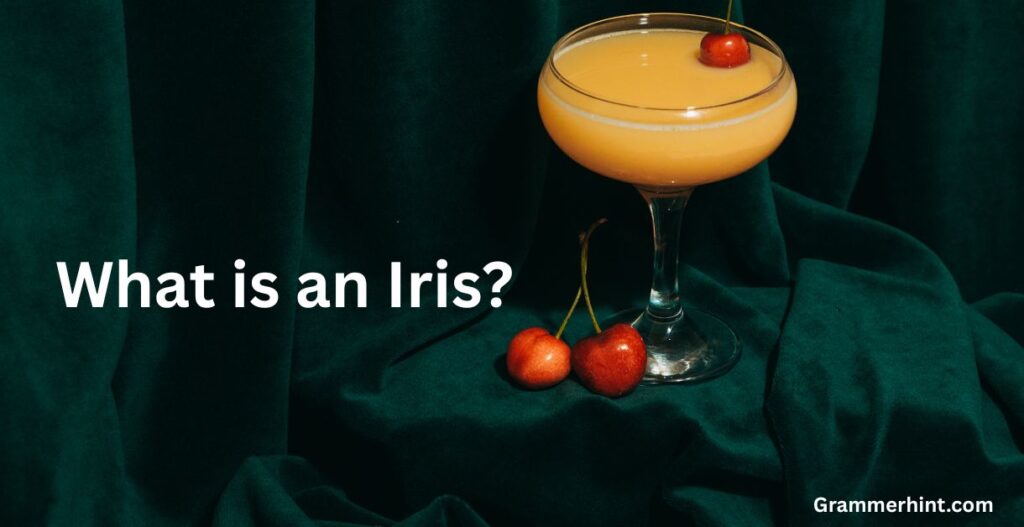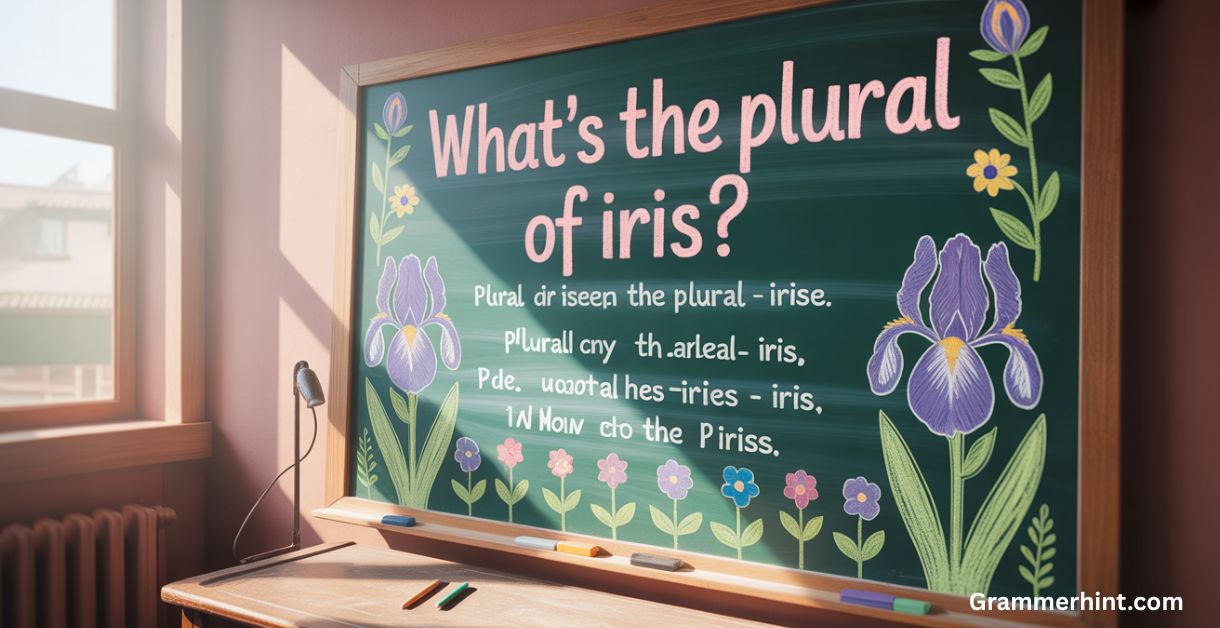When it comes to the plural of iris, many people get tripped up. The confusion grows because “iris” has meanings in both botanical terms (flower genus) and anatomical terms (part of the eye).
Plus, its language origin and etymology influence how we form its plural. So, what’s the plural of iris? Is it irises, irides, or something else?
Let’s get started and clear the fog around this colorful and complex word.
What is the Plural of Iris?
The most common plural form used in English is irises. When you talk about multiple iris flowers or eye irises, people almost always say “irises.” For example:
- The garden is full of blooming irises this spring.
- The doctor examined the patients’ irises during the eye care seminar.
But there’s a less common, more scholarly plural form: irides. This comes directly from the Greek origin pluralization pattern, since iris comes from Greek. Some specialists, especially in botanical or academic circles, prefer “irides” for precision or style.
So, simply put:
- The plural of iris is irises in everyday use.
- Irides is a valid plural but mostly reserved for scientific or classical contexts.
Why Are the Plurals ‘Irises’ and ‘Irides’?

English plural rules can be tricky, especially for words borrowed from Latin and Greek. The word iris entered English through Latin, which itself borrowed from Greek.
- In Latin origin, the plural would typically follow regular English rules, adding -es → irises.
- In Greek origin pluralization, the plural sometimes shifts to -ides, leading to irides.
This happens with many words in English. For instance, “cactus” can be “cacti” or “cactuses.” Here, irises follows the more familiar English pattern, while irides honors the word’s Greek roots.
Botanists and scientists might prefer irides to emphasize classification of species within the flower genus, while optometrists and general speakers stick with irises for simplicity.
What is an Iris?

Before diving further into plurals, it’s helpful to remember the two main meanings of iris:
- Iris as a flower: A genus of colorful, ornamental plants famous for their showy petals (called standards and falls).
- Iris as part of the eye: The colored ring surrounding the pupil, which controls pupil size and regulates how much light enters the eye.
Because of this dual meaning, understanding the plural of iris flower and the plural of iris of the eye separately can help avoid confusion.
Using ‘Iris’ in Sentences (Singular Usage)
Here are some examples showing iris in singular form, across different fields:
- Gardening email:
Hi Sarah, I just planted a new iris in my backyard. The blue petals are stunning! – Mark - Optometrist’s note:
During your exam, I noticed your left iris has a slight pigmentation variation. - Artist’s description:
The painting captures the delicate curves of the iris flower perfectly. - Biology class explanation:
The iris regulates the amount of light that enters the eye by adjusting the pupil size.
Using ‘Irises’ and ‘Irides’ in Sentences (Plural Usage)
Usage of “Irises”:
- Florist’s email:
Dear Emily, the irises you ordered for the wedding arrived this morning. They smell wonderful! - Gardening forum post:
Has anyone had success growing irises in clay soil? - Photography exhibit invitation:
Join us this Saturday for the “Colors of Nature” exhibit featuring close-ups of irises. - Optometrist’s seminar flyer:
Learn about common issues affecting the irises in your patients’ eyes.
Usage of “Irides”:
- Scientific conference abstract:
This study explores genetic variation among different irides of the Iris genus. - Anthropologist’s report:
Artifacts adorned with iridescent colors reminiscent of irides were found in the excavation. - Poet’s journal entry:
Irides of the ancient garden shimmered under moonlight, like jewels caught in time. - Botanical paper:
The classification of these irides relies heavily on petal morphology and habitat.
Origins of the word ‘Iris’
Tracing iris back offers a fascinating glimpse into language borrowing and etymology:
- The word iris comes from Greek, where it meant “rainbow.” This alludes to the flower’s variety of vibrant colors and the eye’s colorful ring.
- Later, the term entered Latin as iris, retaining much of the Greek meaning.
- English adopted iris from Latin, carrying both meanings: the flower genus and the eye’s structure.
The transition from Greek → Latin → English explains why pluralization can be tricky, as English grammar meets Greek and Latin influences.
Conclusion
In everyday English, the plural of iris is almost always irises — whether you’re talking about a bouquet of iris flowers or the colored parts of eyes. It sounds natural, clear, and fits regular plural rules.
However, irides remains a legitimate plural, favored in certain scientific, artistic, or classical contexts. It honors the word’s Greek heritage and adds a touch of scholarly flair.
Knowing the difference helps you choose the right form, whether you’re writing an email as a gardening enthusiast, delivering a presentation as an optometrist, or crafting a poem inspired by artistic depictions of iridescent beauty.









